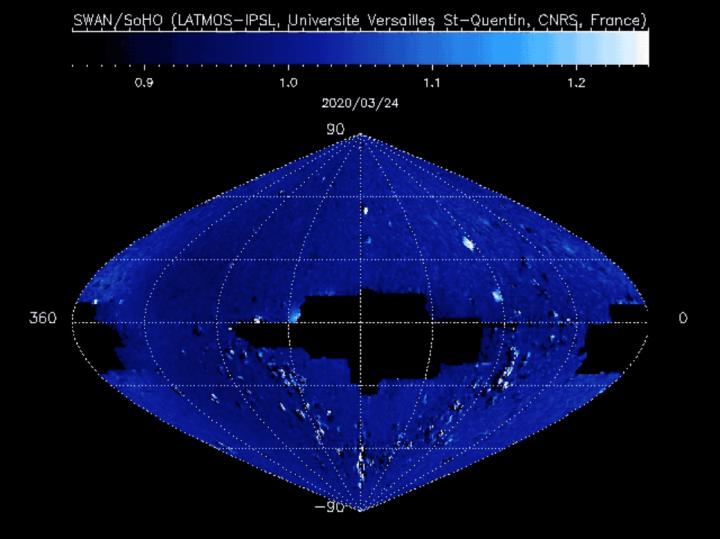New comet discovered by ESA and NASA solar observatory

SOHO Observations of Comet SWAN Credits: ESA/NASA/SOHO
The new comet was first spotted in April 2020, by an amateur astronomer named Michael Mattiazzo using data from a SOHO instrument called Solar Wind Anisotropies, or SWAN — as seen here.
The comet appears to leave the left side of the image and reappear on the right side around May 3, because of the way SWAN's 360-degree all-sky maps are shown, much like a globe is represented by a 2D map.
SWAN maps the constantly outflowing solar wind in interplanetary space by focusing on a particular wavelength of ultraviolet light emitted by hydrogen atoms.
The new comet — officially classified C/2020 F8 (SWAN) but nicknamed Comet SWAN — was spotted in the images because it's releasing huge amounts of water, about 1.3 tons per second. As water is made of hydrogen and oxygen, this release made Comet SWAN visible to SOHO's instruments.
Comet SWAN is the 3,932nd comet discovered using data from SOHO. Almost all of the nearly 4,000 discoveries have been made using data from SOHO's coronagraph, an instrument that blocks out the Sun's bright face using a metal disk to reveal the comparatively faint outer atmosphere, the corona.
This is only the 12th comet discovered with the SWAN instrument since SOHO's launch in 1995, eight of which were also discovered by Mattiazzo.
Comet SWAN makes its closest approach to Earth on May 13, at a distance of about 53 million miles. Comet SWAN's closest approach to the Sun, called perihelion, will happen on May 27.
Though it can be very difficult to predict the behavior of comets that make such close approaches to the Sun, scientists are hopeful that Comet SWAN will remain bright enough to be seen as it continues its journey.
Media Contact
All latest news from the category: Physics and Astronomy
This area deals with the fundamental laws and building blocks of nature and how they interact, the properties and the behavior of matter, and research into space and time and their structures.
innovations-report provides in-depth reports and articles on subjects such as astrophysics, laser technologies, nuclear, quantum, particle and solid-state physics, nanotechnologies, planetary research and findings (Mars, Venus) and developments related to the Hubble Telescope.
Newest articles

Sea slugs inspire highly stretchable biomedical sensor
USC Viterbi School of Engineering researcher Hangbo Zhao presents findings on highly stretchable and customizable microneedles for application in fields including neuroscience, tissue engineering, and wearable bioelectronics. The revolution in…

Twisting and binding matter waves with photons in a cavity
Precisely measuring the energy states of individual atoms has been a historical challenge for physicists due to atomic recoil. When an atom interacts with a photon, the atom “recoils” in…

Nanotubes, nanoparticles, and antibodies detect tiny amounts of fentanyl
New sensor is six orders of magnitude more sensitive than the next best thing. A research team at Pitt led by Alexander Star, a chemistry professor in the Kenneth P. Dietrich…





















